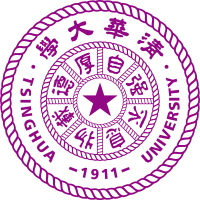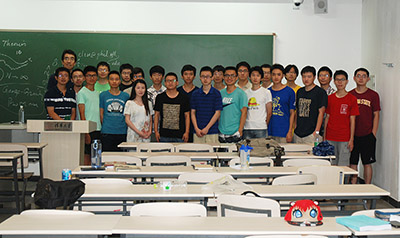

![]()
home
::: about
::: news
::: links
::: giving
::: contact
![]()
events
::: calendar
::: lunchtime
::: annual
lecture series
::: conferences
![]()
people
::: visiting fellows
::: postdoc fellows
::: senior fellows
::: resident fellows
::: associates
![]()
joining
::: visiting fellowships
::: postdoc fellowships
::: senior fellowships
::: resident fellowships
::: associateships
![]()
being here
::: visiting
::: the last donut
::: photo album
|
2015
Chuang Liu, Foundational Issues in Quantum Physics
The universe according to classical physics is furnished at the most fundamental level with particles and fields in space and time. All events in the world boil down to the movements and changes of groups of configured particles in space over time under the influence of force fields. Each particle has a definite position and momentum at each moment, whether or not we can know it, and it interacts with any other particles through a field (or fields) that has a definite strength at each point in space. The behavior of particles and fields is determined by laws of physics and in theory all events are fully determined by such laws and prior events. The hallmarks in classical physics are Newtonian mechanics and Maxwell’s theory of electromagnetism. Because of historical reasons, we consider Einstein’s special theory and the general theory of relativity as extensions of classical physics. The same can never be said for quantum mechanics, not because Einstein’s theories are less revolutionary but because the scope and depth of interpretational problems for relativity are incomparably less than those for quantum theories. With the onset of quantum physics (which includes quantum mechanics and quantum field theories) the classical and largely realist worldview in physics no longer seems to be tenable; and what could a replacement of that worldview be is still a matter of deep controversy. In this lecture series I offer glimpses of the scope and depth of the interpretative challenges in quantum physics.
This five-lecture series is intended for introducing students to several areas in foundations of quantum physics. A familiarity with philosophy of quantum mechanics is not assumed, and therefore the first lecture gives a semi-historical introduction of the mathematical and conceptual fundamentals of quantum mechanics and its interpretational challenges, especially because of the quantum measurement problem. The second lecture discusses the many but not all standard interpretations in the literature. Emphasis will be placed on making clear what the philosophical cost of each interpretation bears. The third lecture covers the issues surrounding the EPR thought experiment and Bell’s Inequalities. I explain in what exact sense a local interpretation of quantum theory is impossible. The fourth and the fifth lecture cover some advanced topics. In the fourth lecture, I look at the basics of the gauge field theories and some recent effort of bring general relativity into the rank of quantum field theories by conceiving gravity as a gauge field. In the fifth lecture I discuss the conceptual possibility of using the notion of spontaneous symmetry breaking to revolve the quantum measurement problem. Throughout the lectures, I keep the mathematical details to a minimum, introducing them whenever they are necessary for a precise understanding of the conceptual issues.
LECTURE 1: Fundamentals of Classical and Quantum Physics
In this lecture we give a semi-historical introduction to the fundamentals of quantum mechanics that is necessary for the students to fully appreciate the interpretational challenges of the theory. Emphasis will be given to showing the transition from the Hamiltonian formalism of classical mechanics and its standard interpretation to the Hamiltonian formalism of quantum mechanics and its interpretational problems. We begin with the non-commutativity of basic (conjugate) physical magnitudes on the microscopic scale and end with the wave-particle duality of microscopic entities. We go through the different representations of quantum mechanics and explain how they are equivalent and how the Hilbert space formulation of quantum mechanics eventually becomes the standard formulation. We explain why the wave-particle duality poses stiff challenges to a realist (or an inline with a classical) understanding of natural phenomena. Stops on our way to an understanding of the interpretational problems include: non-commutativity relations, Heisenberg’s uncertainty principle, the Heisenberg/Schrodinger representations, the Hilbert space formulation of quantum mechanics, the wave-function, the Born probability rule, non-Boolean nature of quantum probability, and the wave-particle duality.
Readings
L. D. Landau and E. M. Lifshitz, Mechanics and Electrodynamics.
Bernard d’Espagnat, Conceptual Foundations of Quantum Mechanics, 2nd ed.,
Parts One and Two.
Michael Redhead, Incompleteness, Nonlocality, and Realism, chapter 1.
Harvey. R. Brown and Rom. Harre, eds. Philosophical Foundations of Quantum Field
Theory, articles 1 and 2.
LECTURE 2: The EPR Argument and the Bell Inequality
In this lecture we first look at the thought experiment from Einstein, Podolsky, and Rosen (EPR), and examine the EPR claim that quantum mechanics is incomplete. We then go through Bell’s argument for the non-local nature of quantum phenomena. Through the setup of a set of inequalities, Bell is able to demonstrate that non-local hidden-variable theories are ruled out. The experimental confirmation of Bell’s conclusion has established a benchmark for the interpretations of quantum theory. We then go back to look at the wave-particle duality of quantum entities and reveal the connection between this duality and Bell’s inequalities. Difference senses of quantum non-locality are also examined in this lecture.
Readings
James T. Chushing and Ernan McMullin eds. Philosophical Consequences of
Quantum Theory: Reflections on Bell’s Theorem. Read the following papers:
D. Mermin, pp. 38-60
J. Jarrett, pp. 60-80
D. Howard, pp. 224-254
Michael Redhead, Incompleteness, Nonlocality, and Realism, chapters 3, 4, 5, and 6.
Bernard d’Espagnat, Conceptual Foundations of Quantum Mechanics, 2nd ed.,
Part Three.
LECTURE 3: The Interpretations of Quantum Mechanics and the Measurement Problem
In this lecture we compare the relative simple task of giving a realist interpretation of a classical mechanical theory and considerable more difficult task of interpreting a quantum theory. We then go through the many alternative interpretations of quantum mechanics and reflect on the problems they have. We see in what sense the problem of quantum measurement constitutes the core difficulty of coming up with a straightforward interpretation. The selected list of the interpretations we consider consists of the Copenhagen interpretation, the propensity interpretation, the Bohmian mechanical interpretation, the modal interpretation (one variety of it as an example), the GRW interpretation, the Wigner interpretation, and the many-world interpretation.
Readings
Michael Redhead, Incompleteness, Nonlocality, and Realism, chapter 2.
Bernard d’Espagnat, Conceptual Foundations of Quantum Mechanics, 2nd ed.,
Parts Four & Five.
LECTURE 4: The Quantum Gauge Field Theory and the Problems for a Theory of Gauge Gravity
In this lecture we introduce the theory of the Yang-Mills quantum gauge field and look at how the theory provides hope for a unified field theory in physics. We begin with the idea of gauge field in the classical field theory, such as in classical electrodynamics. The Yang-Mills theory of quantum gauge field is then introduced. We see how the idea of localized gauge invariance gives us a mathematical method of introducing a gauge field into a theory. The idea is then compared with Einstein’s general covariance principle, whose core idea is strikingly similar to that of the localized gauge invariance principle. Decades of effort have been made to formulate general relativity, which is a classical field theory of gravity, as a gauge field theory. We get a glimpse of the difficulties of constructing a theory of quantum gauge gravity, and discuss a recent revival of the idea.
Readings
Lochlainn O’Raifeartaigh, The Dawning of Gauge Theory.
Richard Healey, Gauging What’s Real: The Conceptual Foundations of Contemporary
Gauge Theories.
LECTURE 5: Beyond Hilbert Space: An Algebraic Approach to the Quantum Measurement Problem
In this lecture we discuss the viability of using the technique of the algebraic approach and taking the thermodynamic limit to come up with a model of quantum measurement that goes beyond the confine of the Hilbert space formalism and resolves the measurement problem along the decoherentist line. It utilizes the notion of the emergence of non-unitary representations at the thermodynamic limit of a quantum system to arrive at disentangled states that account for the emergence of classical states (i.e. a decoherence that does not require “hand-waving” moves). We discuss the simple model proposed first by Hepp and then improved upon by Emch, hence the Hepp-Emch model, and assess the viability of the model. Further improvement is introduced to make the model more robust. Remaining problems for the model are discussed in this lecture. The nature of idealization and approximation in this approach is also discussed.
Readings
Harvey. R. Brown and Rom. Harre, eds. Philosophical Foundations of Quantum Field
Theory, articles 8 and 9.
N. P. Landsman (1995). Observation and Superselection in Quantum Mechanics.
Studies in History and Philosophy of Science Part B 26 (1): 45-73.
Gerard G. Emch, Algebraic Methods in Statistical Mechanics and Quantum Field
Theory, chapter 1.
1 The readings for these five lectures can only be taken approximately, and therefore do not give them to students to study closely.

